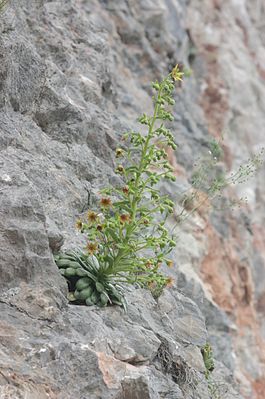Gravel saxifrage
| Gravel saxifrage | ||||||||||||
|---|---|---|---|---|---|---|---|---|---|---|---|---|

Gravel saxifrage ( Saxifraga mutata ) |
||||||||||||
| Systematics | ||||||||||||
|
||||||||||||
| Scientific name | ||||||||||||
| Saxifraga mutata | ||||||||||||
| L. |
The gravel-saxifrage ( Saxifraga mutata ) is a species of the genus saxifrage ( Saxifraga ) in the family Saxifragaceae (Saxifragaceae).
features
The gravel saxifrage is a perennial plant that reaches heights of 10 to 60 centimeters. Despite the sometimes stately inflorescences, the gravel quarry is a weakly competitive plant. It grows loose-grass and forms leaf rosettes up to 12 centimeters in size . The leaves are 10 to 60 millimeters long, 7 to 12 millimeters wide, oblong-tongue-shaped to linear , blunt, fleshy, leathery and shiny dark green. The edge is cartilaginous, imperforate and stiff ciliate at the base. There are numerous leaves that are more spatulate on the stem . It has glandular hairs, branches out below the middle and has a rich-flowered, paniculate inflorescence . The petals have a length of 5 to 8 millimeters and are linear-lanceolate, pointed and colored lemon yellow to deep orange. The sepals are only half as long, egg-shaped and glandular.
Flowering time is from June to August.
The species has chromosome number 2n = 16, 26, 28 or 32.
Occurrence
The gravel saxifrage occurs in the Alps and in the foothills of the Alps from montane to subalpine on moist rocks ( Nagelfluh , sandstone , marl , limestone and slate ) and on clayey soils at altitudes of 800 to 2200 meters. It is also found in the Carpathian Mountains. In the Allgäu Alps, it rises up to 1250 meters above sea level. The regression or absence of this species in the central Alps is attributed to the Pleistocene glaciation of the Alps. The species, which preferentially settle in lower elevations, was more severely affected than the related high-alpine species that could survive on Nunatakkern . The internationally unique occurrences of Alpine rivers (Lech, Wertach and Isar) have decreased significantly in the last 20 years.
ecology
The gravel saxifrage loves seeping wet, lime-rich, humus and fine earth poor stone and gravel soils in humid, shaded locations. It is a character species of the Astero-bellidiastri-Saxifragetum-mutatae (Association Caricion davallianae), but also occurs in societies of the Cratoneurion commutati or the Potentillion caulescentis.
Subspecies
Two subspecies are known of the gravel saxifrage:
- Saxifraga mutata subsp. demissa (Schott & Kotschy) DA Webb (Syn .: Saxifraga demissa Schott & Kotschy ); this subspecies occurs only in the southern Carpathians; it has the number of chromosomes 2n = 16.
- Saxifraga mutata subsp. mutata ; it occurs in the Alps and rarely in the Carpathians.
literature
- Xaver Finkenzeller, Jürke Grau : Alpine flowers (Steinbach's natural guide). Mosaik Verlag GmbH, Munich 1996, ISBN 3-576-10558-1 .
- Herbert FJ Huber in Gustav Hegi : Illustrated flora of Central Europe . 2nd edition, Volume IV, Part 2 A, pages 162-163. Carl Hanser Publishing House, Munich, 1961.
Individual evidence
- ↑ Quinger B., Dr. Zehm A .: Kies-Steinbrach, Saxifraga mutata L. Bavarian State Office for the Environment, November 2009, accessed on March 15, 2018 .
- ↑ a b Jaakko Jalas, Juha Suominen, Raino Lampinen, Arto Kurtto: Atlas florae europaeae . Volume 12 (Resedaceae to Platanaceae). Page 168, Helsinki 1999. ISBN 951-9108-12-2 .
- ↑ Erhard Dörr, Wolfgang Lippert : Flora of the Allgäu and its surroundings. Volume 1, IHW, Eching 2001, ISBN 3-930167-50-6 , p. 658.
- ^ Erich Oberdorfer : Plant-sociological excursion flora for Germany and neighboring areas . 8th edition. Page 489. Stuttgart, Verlag Eugen Ulmer, 2001. ISBN 3-8001-3131-5
Web links
- Gravel saxifrage. In: FloraWeb.de.
- Distribution map for Germany. In: Floraweb .
- Saxifraga mutata L. In: Info Flora , the national data and information center for Swiss flora . Retrieved November 1, 2015.
